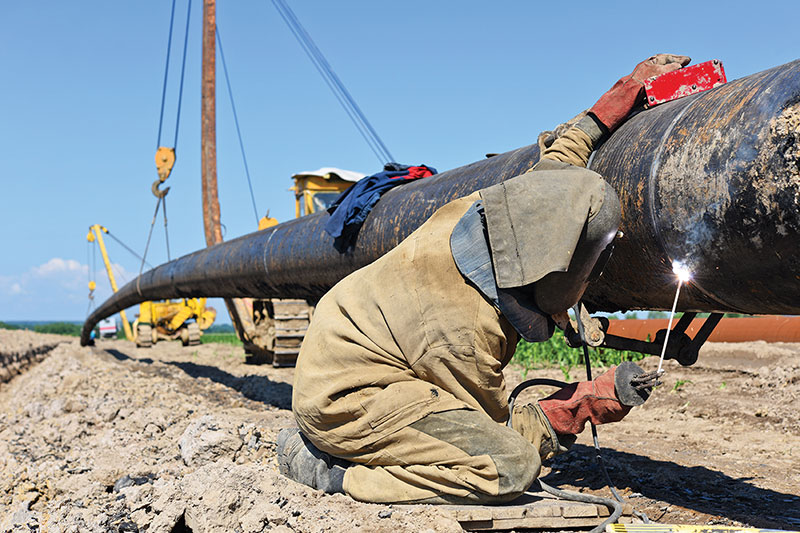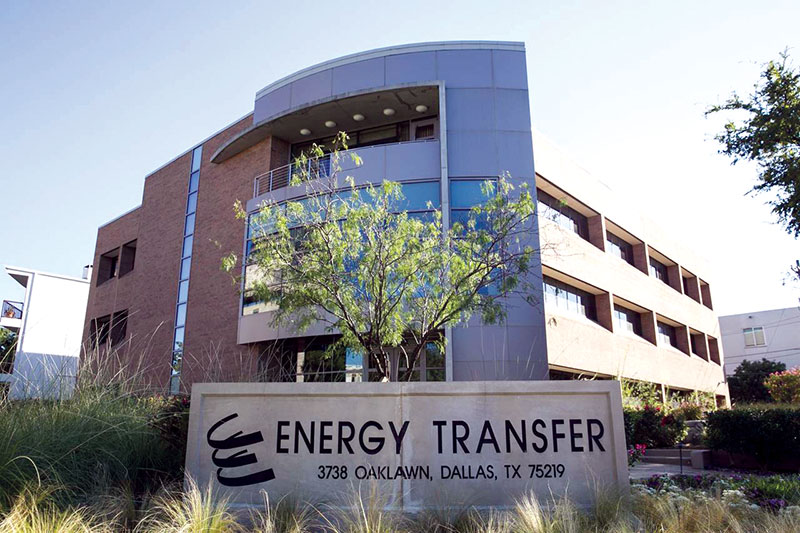March 2021, Vol. 248, No. 3
Global News
Global News March 2021
Unions Supported Biden, but Push for Pipelines
Environmentalists and labor unions that supported President Joseph Biden now find themselves on opposite sides of a battle over the construction of big pipeline projects between Canada and the United States.
The Biden administration plans to transition the U.S. economy toward net-zero carbon emissions by 2050, which means less oil and gas. The reaction from Biden’s supporters, however, illustrates the challenge of managing the impact of the energy transition on different communities.

While climate activists celebrated the president’s decision to stop the Keystone XL pipeline from Canada into the U.S. Midwest, labor unions have mobilized to keep ongoing projects from being derailed.
Mike Knisely, secretary and treasurer of the Ohio State Building and Construction Trades Council, which endorsed Biden, said he has been leaning on state officials to talk to the president about how his climate announcements are affecting his union membership’s support.
Climate groups have had successes in recent years, persuading large investors to reduce holdings in fossil fuel industries, as well as lobbying banks to shun investment in Arctic drilling.
But Biden was endorsed by several key labor unions that work on pipelines, refineries and other energy installations, including the International Teamsters and North America’s Building Trades. Those unions celebrated the victory of a pro-labor president, but opposed the Keystone move, and are lining up against threats to the other pipelines.
Environmentalists see Biden as an ally in the battle to wean the United States off fossil fuels and stymie imports of carbon-intensive heavy crude from Canada’s vast oil sands. They are intensifying efforts to shut three other pipelines: Enbridge Inc’s Line 3 and Line 5, and Energy Transfer’s Dakota Access Pipeline (DAPL).
Unlike KXL, these three lines are all currently in service. The Enbridge lines deliver crude oil and fuels from Canada, while DAPL sends crude from North Dakota to the Midwest and Gulf Coast.
FERC to Add Environmental Justice Position
The chairman of the U.S. Federal Energy Regulatory Commission (FERC) said the panel will create a senior position on environmental justice to ensure new energy projects, such as pipelines and LNG facilities, do not unfairly harm minority communities.
“I believe that the Commission should more aggressively fulfill its responsibilities to ensure our decisions don’t unfairly impact historically marginalized communities,” said Richard Glick, a Democrat who was appointed by President Joe Biden.
While the panel is required to consider green justice issues under the National Environmental Policy Act, Glick said in recent years, it has not always emphasized its responsibility.
Glick said FERC will spend more time considering whether fossil fuel projects would expose nearby residents to a lot of particulate pollutants such as nitrogen oxide, or NOX.
FERC should consider whether pollution impacts on communities could be mitigated by moving the projects or installing more pollution controls, Glick said.
Saudi Aramco Plans $10 Billion Financing for Pipeline Buyers
Saudi Aramco is preparing a financing package of up to $10 billion that it could offer to buyers of its pipeline business unit, three sources told Reuters
International investors including BlackRock, KKR and Brookfield Asset Management, which could invest in the pipeline business, are also in talks with lenders on possible financing, said the sources, speaking anonymously because the talks are private.
Aramco and Brookfield declined to comment. BlackRock and KKR did not respond to comment requests.
The planned pipeline sale would be similar to infrastructure deals signed over the last two years by Abu Dhabi’s national oil company ADNOC, which raised billions of dollars by leasing its oil and gas pipeline assets to investors, sources have previously said.
Norway Oil Firms Raise 2021 Investment Plans
Oil and gas firms in Norway have increased their 2021 investment plans in recent months, but still plan to spend less than last year and to reduce spending in 2022, a national statistics office (SSB) survey showed
The biggest sector in Norway now expects to invest 173.6 billion Norwegian crowns ($20.5 billion) this year, up from a forecast of 166.3 billion in November, the SSB said, but that still lags last year’s 179.3 billion.
Its initial forecast for 2022 stood at 138 billion, some 8.9% lower than predictions for 2021 a year ago, SSB said.
Last year, Norway’s parliament approved temporary tax incentives to spur oil and gas investments, triggering promises by Equinor and others to accelerate development of existing finds to bring them on stream.
To qualify for the incentives, which could reduce development costs by around $10 per barrel of oil according to industry estimates, projects need to be approved by the end of 2022.
Argentina’s Shale Oil Drives Rebounding Prices
Oil output from the Vaca Muerta region in Patagonia, which holds the fourth-largest shale oil reserves in the world, hit a record high of 124,000 bpd in December as producers revved up wells with an eye on rebounding prices and a new export market.
The revival of the formation, after stalling during the coronavirus pandemic, signals how it is growing more competitive globally, helped by government policies protecting oil producers, an export tax holiday, and reviving global prices.
Producers are focusing on exports with the oil taken up to 560 miles (900 km) to the port of Puerto Rosales by pipeline which can flow 157,000 bpd, with plans to expand this to 220,000 bpd this year and eventually to 415,000 bpd.
The reserves’ revival could bring a timely injection of much needed dollars for the country’s Peronist government, which has grappled with a sharp decline in foreign reserves due to the coronavirus pandemic and a currency crisis hammering the peso.
Germany Planning Phased Intro of Hydrogen Pipeline Transport
German lawmakers have introduced a plan to phase in carbon-free hydrogen fuel in the country’s transport sector. Their plan’s initial focus on switching pipelines now carrying hydrogen made from fossil fuels to carry “green” hydrogen, which is made from wind and solar energy via electrolysis, and the building of new green hydrogen pipelines.
It does not provide for the immediate absorption of green hydrogen into existing natural gas grids, which are regulated local monopolies.
Some operators of Germany’s 314,754 miles (550,000 km) of gas transport grids have pushed for a quicker integration of systems, arguing this would ramp-up the use of green hydrogen and help refinance their green hydrogen investments via grid usage fees.
The plan explicitly calls the law a “transitory arrangement” that would allow a step-by-step approach to putting the country’s 9-billion-euro ($10.89 billion) hydrogen strategy into practice. The ultimate integration of gas and hydrogen grids remained “a matter of many years,” it said.
The law will have to be passed by parliament as part of a set of energy initiatives the government wants to complete before the summer break and a general election in September
Chevron Offers to Buy Out Noble Midstream
Chevron Corp said in February that it had offered to buy Noble Midstream Partners LP in a deal valuing the company at $1.13 billion, months after the U.S. oil major bought the pipeline operator’s sponsor, Noble Energy.
Chevron closed a $4.1 billion, all-stock purchase of smaller rival Noble Energy in October, gaining a majority stake in Noble Midstream alongside large shale and international natural gas reserves. Now Noble Midstream’s largest customer, Chevron said taking full ownership of the assets will help it streamline their governance and is in line with the producer’s long-term interests.
Noble Midstream provides crude oil, natural gas and water-related midstream services in the DJ Basin in Colorado and the Delaware Basin in Texas.
Qatar Signs Engineering, Construction Contract for LNG Expansion
Qatar Petroleum, the world’s top liquefied natural gas supplier, has signed a contract for the first phase of expanding its North Field gas project, which will boost the country’s LNG output by more than 40% to 110 mtpa by 2026.
The $13 billion contract – which covers major onshore engineering, procurement and construction — was signed with a joint venture of Japan-based Chiyoda and U.K.-based TechnipFMC and is known as North Field East. It is the largest single LNG project ever sanctioned, according to global energy consultancy Wood Mackenzie.
Production will start by the fourth quarter of 2025 and reach full capacity by late 2026 or early 2027, Qatar Petroleum CEO Saad al-Kaabi said in a virtual news conference.
“The total cost of the project will be $28.7 billion, making it one of the industry’s largest investments in the past few years and largest LNG capacity ever built,” said Kaabi, who is also Qatar’s energy minister.
He said he expects a decision to finalize partnerships for the field’s expansion by the end of this year. ExxonMobil, Shell, Total and ConocoPhillips are longstanding partners in Qatar’s existing fleet of LNG plants.
Energy Transfer to Acquire Enable Midstream for $7 Billion

Dallas-based Energy Transfer has agreed to acquire Oklahoma City’s Enable Midstream Partners in an all-stock deal valued at $7.2 billion deal, the companies announced.
Enable owns and operates about 14,000 miles of natural gas, crude oil, condensate and produced water gathering pipelines, about 2.6 Bcf/d of natural gas and processing capacity, about 10,000 miles of interstate pipelines and seven natural gas storage facilities, according to the company.
The deal expands Energy Transfer’s NGL infrastructure by adding natural gas gathering and processing assets in the Anadarko Basin in Oklahoma, integrating Enable’s assets with its existing NGL transportation and fractionation assets on the U.S. Gulf Coast. The acquisition will also provide Energy Transfer with significant gas gathering and processing assets in the Arkoma basin across Oklahoma and Arkansas, as well as the Haynesville Shale in East Texas and North Louisiana.
Enable’s transportation and storage assets enhance Energy Transfer’s access to core markets with consistent sources of demand and bolster its portfolio of customers anchored by large, investment-grade customers with firm, long-term contracts. Energy Transfer will further enhance its connectivity to the global LNG market and the growing global demand for natural gas as the world transitions to cleaner power and fuel sources.
“Energy Transfer expects the combined company to generate more than $100 million of annual run-rate cost and efficiency synergies, excluding potential financial and commercial synergies,” according to its announcement of the deal. “Potential commercial synergies include significant incremental earnings, which may result from integrating Enable’s Anadarko gathering and processing complex with Energy Transfer’s fractionation assets on the U.S. Gulf Coast.”
Energy Transfer’s core operations include natural gas midstream, intrastate and interstate transportation and storage assets; crude oil, NGL and refined product transportation and terminating assets; NGL fractionation; and various acquisition and marketing assets.





Comments